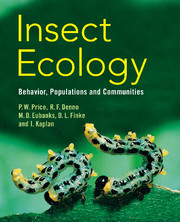Book contents
- Frontmatter
- Contents
- Preface
- Acknowledgments
- Part I Introduction
- Part II Behavioral ecology
- Part III Species interactions
- 4 Plant and herbivore interactions
- 5 Lateral interactions: competition, amensalism and facilitation
- 6 Mutualisms
- 7 Prey and predator interactions
- 8 Parasite and host interactions
- Part IV Population ecology
- Part V Food webs and communities
- Part VI Broad patterns in nature
- Glossary
- References
- Author Index
- Taxonomic Index
- Subject Index
- Plate section
- References
5 - Lateral interactions: competition, amensalism and facilitation
from Part III - Species interactions
Published online by Cambridge University Press: 05 June 2012
- Frontmatter
- Contents
- Preface
- Acknowledgments
- Part I Introduction
- Part II Behavioral ecology
- Part III Species interactions
- 4 Plant and herbivore interactions
- 5 Lateral interactions: competition, amensalism and facilitation
- 6 Mutualisms
- 7 Prey and predator interactions
- 8 Parasite and host interactions
- Part IV Population ecology
- Part V Food webs and communities
- Part VI Broad patterns in nature
- Glossary
- References
- Author Index
- Taxonomic Index
- Subject Index
- Plate section
- References
Summary
In the preceding chapter, we focused on interactions between phytophagous insects and their host plants and saw how species occupying different trophic levels can influence each other's abundance, distribution and evolution. Other important intertrophic level relationships include predator–prey and host–parasitoid interactions, and these will be dealt with in forthcoming chapters (see Chapters 7 and 8). Here we consider lateral interactions, those that occur among individuals feeding at the same trophic level, and how such interactions (e.g., competition, amensalism, facilitation and mutualism) can affect species' abundance, distribution and community structure. Because lateral interactions, and in particular competition, have been studied so extensively using herbivorous insects, we begin our consideration of the topic focusing on this group of consumers, deferring our treatment of lateral interactions in other insect consumer groups (e.g., detritivores, scavengers, predators and parasitoids) to a bit later in the chapter.
Lateral interactions between insect herbivores can be negative (competition and amensalism), neutral or positive (facilitation and mutualism) (Damman 1993, Denno et al. 1995, Denno and Kaplan 2007, Kaplan and Denno 2007). In competitive interactions, both participants (either conspecifics or heterospecifics) are negatively affected (−, −), whereas in cases of amensalism one of the players suffers from the interaction but the other remains unaffected (−, 0). Positive interactions include facilitation when at least one organism benefits from the interaction (+, 0) and mutualistic interactions in which both participants benefit (+, +) (Bruno et al. 2003, Bourtzis and Miller 2006). Moreover, mutualisms can involve tightly coevolved obligate interactions, such as aphids and their bacterial symbionts, or they can entail much looser facultative relationships, such as generalist pollinators and their nectar source plants. Because of the complexity and often intertrophic nature of mutualisms (e.g., protectionist ants and plants that offer rewards), we devote a whole chapter to this fascinating topic (Chapter 6). There we discuss only positive interactions between organisms feeding at the same trophic level, although the strength of such interactions (and negative ones as well) are often mediated by basal resources (plants) and natural enemies (Denno et al. 1995, Denno and Kaplan 2007, Kaplan and Denno 2007).
- Type
- Chapter
- Information
- Insect EcologyBehavior, Populations and Communities, pp. 184 - 223Publisher: Cambridge University PressPrint publication year: 2011
References
- 3
- Cited by



